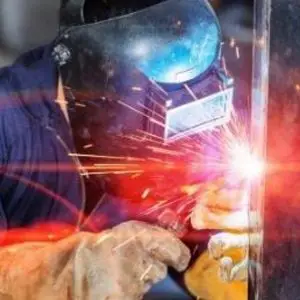Welding produces intense heat and ultraviolet light, which can be harmful to your skin and eyes. But did you know that welding also produces infrared radiation?
What is welding?
Welding is a process of joining two pieces of metal together by heating the metals to melting point and then cooling them. The molten metal that is used to join the two pieces is called filler metal. Welding can be done with or without filler metal.
What is infrared radiation?
Infrared radiation is a type of electromagnetic radiation. Electromagnetic radiation is energy that travels and spreads out as it goes – the waves of energy caused by infrared radiation are similar to radio waves and microwaves, but they are invisible to the human eye.
Infrared radiation is emitted by all objects that have a temperature above absolute zero (-273.15°C). The higher the object’s temperature, the more infrared radiation it emits. The Sun emits large amounts of infrared radiation, which is why we feel warm when we are exposed to sunlight.
What are the dangers of infrared radiation?
The three main types of injuries that can be caused by exposure to infrared radiation are:
- Burns
- Cataracts
- Retinal damage
Does welding give off infrared radiation?
All welding processes give off infrared radiation. The amount of infrared radiation given off by welding depends on the welding process, the power output of the welding machine, and the type of electrode being used.
While welding does give off infrared radiation, the levels are typically not high enough to be harmful. However, it is important to be aware of the potential risks and take precautions to protect yourself.
Welding produces a bright light that can damage your eyes. You should always wear a welding helmet with a filter that is designed to block out infrared radiation. In addition, you should avoid looking directly at the welding arc.
Welding can also produce harmful fumes that you should avoid inhaling. Always work in a well-ventilated area and use a respirator if necessary.
If you are concerned about exposure to infrared radiation, you can ask your employer for information about the welding process and the precautions that are in place to protect workers.
How to protect yourself from infrared radiation?
There are three main ways to protect yourself from infrared radiation:
- Use personal protective equipment (PPE), including welding gloves, aprons, and face shields.
- Increase the distance between you and the source of radiation.
- Reduce your exposure time.
What are the benefits of welding?
Welding is joining two pieces of metal together by using electricity to create enough heat to melt the metal. There are many benefits to welding, including:
- Welding is very versatile and can be used to join a variety of metals.
- Welding is strong and can create a permanent join.
- Welding is quick and efficient.
- Welding can be done in a variety of settings, including outdoors.
What are the types of welding?
Different types of welding are used for different purposes. The most common types are:
- Shielded Metal Arc Welding (SMAW): An electrode is used to create an arc between the metal being welded and the electrode. This arc heats up the metals, which creates a molten pool that cools to create a weld.
- Gas Metal Arc Welding (GMAW): A wire is fed through a welding torch, and an arc is created between the wire and the metals being welded. This arc heats up the metals, which creates a weld.
- Gas Tungsten Arc Welding (GTAW): A non-consumable tungsten electrode is used to create an arc between the metal being welded and the electrode. This arc heats up the metals, which creates a weld.
- Flux Cored Arc Welding (FCAW): A wire is fed through a welding torch, and an arc is created between the wire and the metals being welded. This arc heats up the metals, which creates a molten pool that cools to create a weld.
In Closing
Infrared radiation is invisible to the human eye, but it can be felt as heat. And when it comes to welding, infrared radiation can be intense enough to cause burns. So if you’re planning on taking up welding as a hobby, make sure you wear proper protective gear to shield yourself from the harmful effects of infrared radiation.

